Yushuo Guan
VersaVid-R1: A Versatile Video Understanding and Reasoning Model from Question Answering to Captioning Tasks
Jun 10, 2025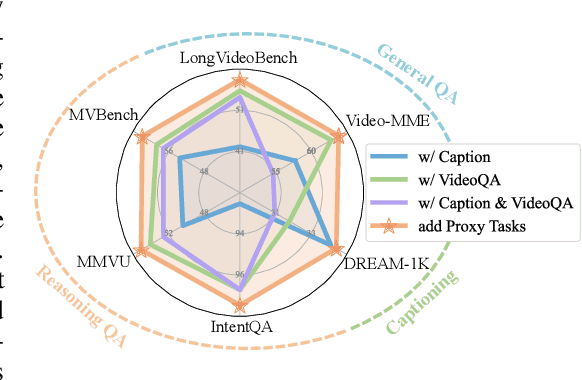

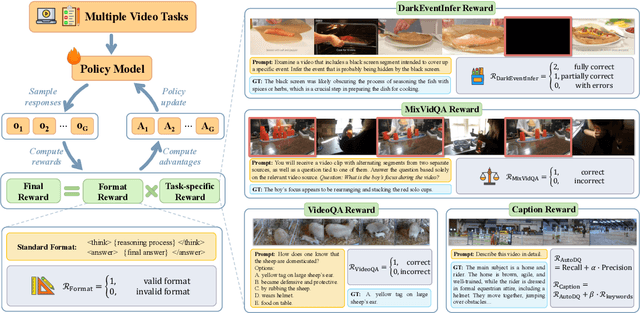

Abstract:Recent advancements in multimodal large language models have successfully extended the Reason-Then-Respond paradigm to image-based reasoning, yet video-based reasoning remains an underdeveloped frontier, primarily due to the scarcity of high-quality reasoning-oriented data and effective training methodologies. To bridge this gap, we introduce DarkEventInfer and MixVidQA, two novel datasets specifically designed to stimulate the model's advanced video understanding and reasoning abilities. DarkEventinfer presents videos with masked event segments, requiring models to infer the obscured content based on contextual video cues. MixVidQA, on the other hand, presents interleaved video sequences composed of two distinct clips, challenging models to isolate and reason about one while disregarding the other. Leveraging these carefully curated training samples together with reinforcement learning guided by diverse reward functions, we develop VersaVid-R1, the first versatile video understanding and reasoning model under the Reason-Then-Respond paradigm capable of handling multiple-choice and open-ended question answering, as well as video captioning tasks. Extensive experiments demonstrate that VersaVid-R1 significantly outperforms existing models across a broad spectrum of benchmarks, covering video general understanding, cognitive reasoning, and captioning tasks.
Mavors: Multi-granularity Video Representation for Multimodal Large Language Model
Apr 14, 2025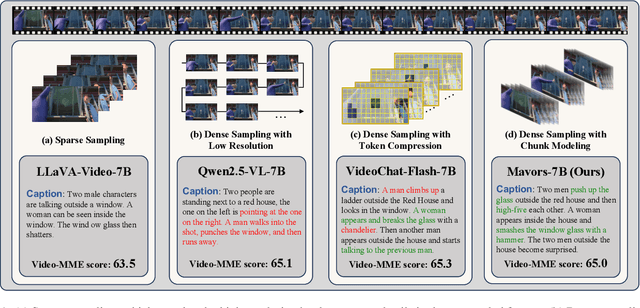

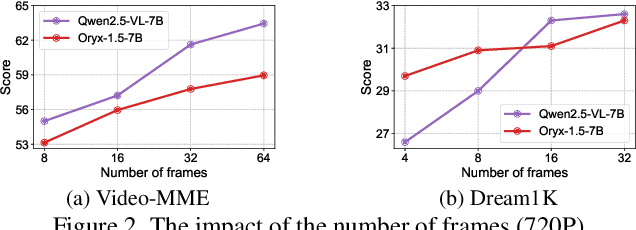
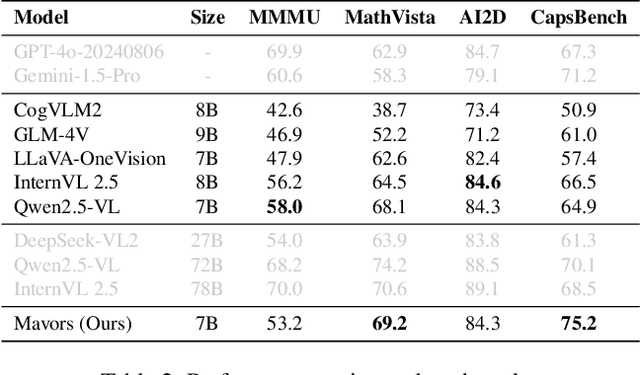
Abstract:Long-context video understanding in multimodal large language models (MLLMs) faces a critical challenge: balancing computational efficiency with the retention of fine-grained spatio-temporal patterns. Existing approaches (e.g., sparse sampling, dense sampling with low resolution, and token compression) suffer from significant information loss in temporal dynamics, spatial details, or subtle interactions, particularly in videos with complex motion or varying resolutions. To address this, we propose $\mathbf{Mavors}$, a novel framework that introduces $\mathbf{M}$ulti-gr$\mathbf{a}$nularity $\mathbf{v}$ide$\mathbf{o}$ $\mathbf{r}$epre$\mathbf{s}$entation for holistic long-video modeling. Specifically, Mavors directly encodes raw video content into latent representations through two core components: 1) an Intra-chunk Vision Encoder (IVE) that preserves high-resolution spatial features via 3D convolutions and Vision Transformers, and 2) an Inter-chunk Feature Aggregator (IFA) that establishes temporal coherence across chunks using transformer-based dependency modeling with chunk-level rotary position encodings. Moreover, the framework unifies image and video understanding by treating images as single-frame videos via sub-image decomposition. Experiments across diverse benchmarks demonstrate Mavors' superiority in maintaining both spatial fidelity and temporal continuity, significantly outperforming existing methods in tasks requiring fine-grained spatio-temporal reasoning.
VidCapBench: A Comprehensive Benchmark of Video Captioning for Controllable Text-to-Video Generation
Feb 18, 2025Abstract:The training of controllable text-to-video (T2V) models relies heavily on the alignment between videos and captions, yet little existing research connects video caption evaluation with T2V generation assessment. This paper introduces VidCapBench, a video caption evaluation scheme specifically designed for T2V generation, agnostic to any particular caption format. VidCapBench employs a data annotation pipeline, combining expert model labeling and human refinement, to associate each collected video with key information spanning video aesthetics, content, motion, and physical laws. VidCapBench then partitions these key information attributes into automatically assessable and manually assessable subsets, catering to both the rapid evaluation needs of agile development and the accuracy requirements of thorough validation. By evaluating numerous state-of-the-art captioning models, we demonstrate the superior stability and comprehensiveness of VidCapBench compared to existing video captioning evaluation approaches. Verification with off-the-shelf T2V models reveals a significant positive correlation between scores on VidCapBench and the T2V quality evaluation metrics, indicating that VidCapBench can provide valuable guidance for training T2V models. The project is available at https://github.com/VidCapBench/VidCapBench.
DAIS: Automatic Channel Pruning via Differentiable Annealing Indicator Search
Nov 04, 2020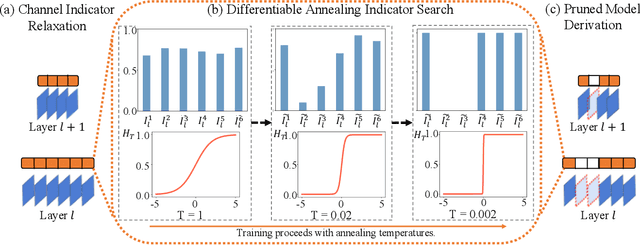
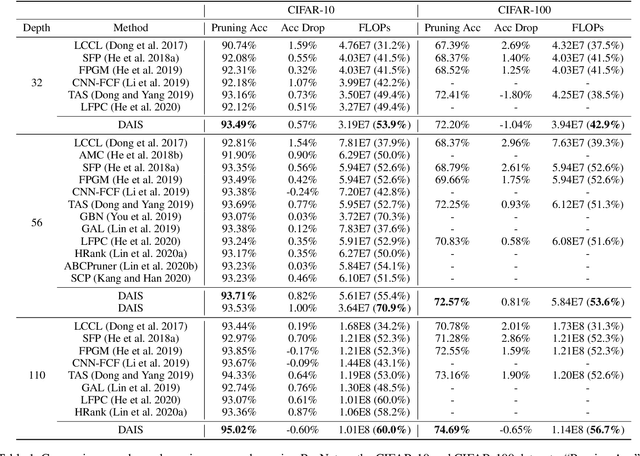
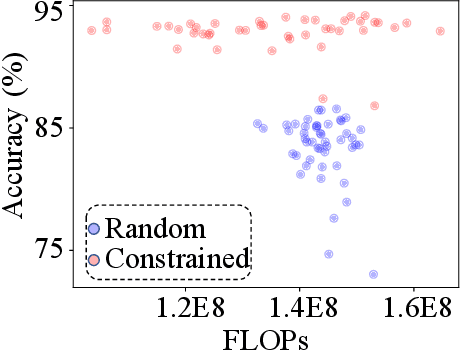

Abstract:The convolutional neural network has achieved great success in fulfilling computer vision tasks despite large computation overhead against efficient deployment. Structured (channel) pruning is usually applied to reduce the model redundancy while preserving the network structure, such that the pruned network can be easily deployed in practice. However, existing structured pruning methods require hand-crafted rules which may lead to tremendous pruning space. In this paper, we introduce Differentiable Annealing Indicator Search (DAIS) that leverages the strength of neural architecture search in the channel pruning and automatically searches for the effective pruned model with given constraints on computation overhead. Specifically, DAIS relaxes the binarized channel indicators to be continuous and then jointly learns both indicators and model parameters via bi-level optimization. To bridge the non-negligible discrepancy between the continuous model and the target binarized model, DAIS proposes an annealing-based procedure to steer the indicator convergence towards binarized states. Moreover, DAIS designs various regularizations based on a priori structural knowledge to control the pruning sparsity and to improve model performance. Experimental results show that DAIS outperforms state-of-the-art pruning methods on CIFAR-10, CIFAR-100, and ImageNet.
Differentiable Feature Aggregation Search for Knowledge Distillation
Aug 02, 2020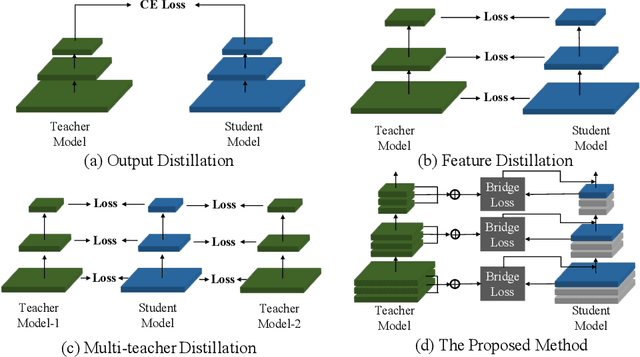
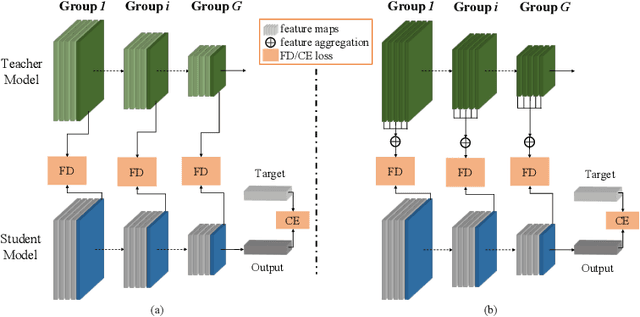

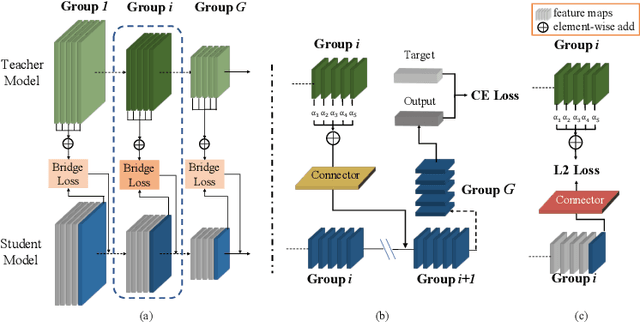
Abstract:Knowledge distillation has become increasingly important in model compression. It boosts the performance of a miniaturized student network with the supervision of the output distribution and feature maps from a sophisticated teacher network. Some recent works introduce multi-teacher distillation to provide more supervision to the student network. However, the effectiveness of multi-teacher distillation methods are accompanied by costly computation resources. To tackle with both the efficiency and the effectiveness of knowledge distillation, we introduce the feature aggregation to imitate the multi-teacher distillation in the single-teacher distillation framework by extracting informative supervision from multiple teacher feature maps. Specifically, we introduce DFA, a two-stage Differentiable Feature Aggregation search method that motivated by DARTS in neural architecture search, to efficiently find the aggregations. In the first stage, DFA formulates the searching problem as a bi-level optimization and leverages a novel bridge loss, which consists of a student-to-teacher path and a teacher-to-student path, to find appropriate feature aggregations. The two paths act as two players against each other, trying to optimize the unified architecture parameters to the opposite directions while guaranteeing both expressivity and learnability of the feature aggregation simultaneously. In the second stage, DFA performs knowledge distillation with the derived feature aggregation. Experimental results show that DFA outperforms existing methods on CIFAR-100 and CINIC-10 datasets under various teacher-student settings, verifying the effectiveness and robustness of the design.
A New Perspective for Flexible Feature Gathering in Scene Text Recognition Via Character Anchor Pooling
Feb 10, 2020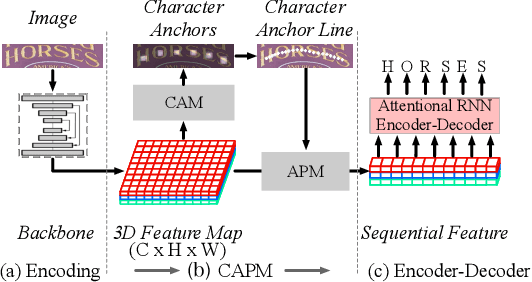

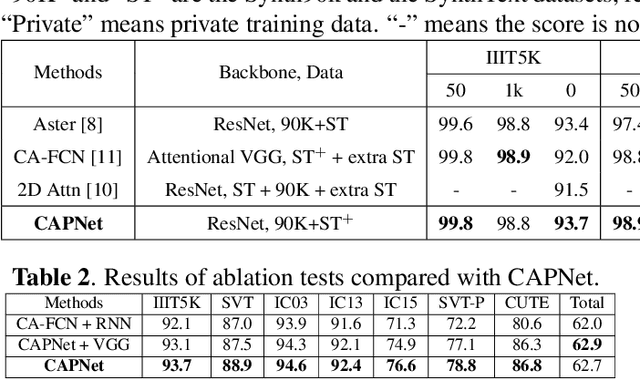
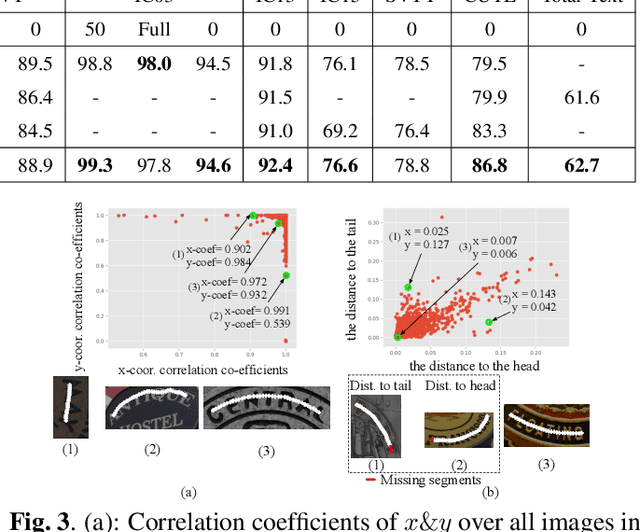
Abstract:Irregular scene text recognition has attracted much attention from the research community, mainly due to the complexity of shapes of text in natural scene. However, recent methods either rely on shape-sensitive modules such as bounding box regression, or discard sequence learning. To tackle these issues, we propose a pair of coupling modules, termed as Character Anchoring Module (CAM) and Anchor Pooling Module (APM), to extract high-level semantics from two-dimensional space to form feature sequences. The proposed CAM localizes the text in a shape-insensitive way by design by anchoring characters individually. APM then interpolates and gathers features flexibly along the character anchors which enables sequence learning. The complementary modules realize a harmonic unification of spatial information and sequence learning. With the proposed modules, our recognition system surpasses previous state-of-the-art scores on irregular and perspective text datasets, including, ICDAR 2015, CUTE, and Total-Text, while paralleling state-of-the-art performance on regular text datasets.
Alchemy: Techniques for Rectification Based Irregular Scene Text Recognition
Aug 30, 2019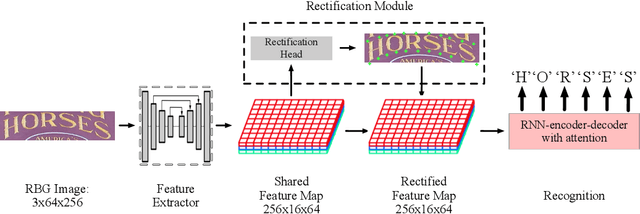
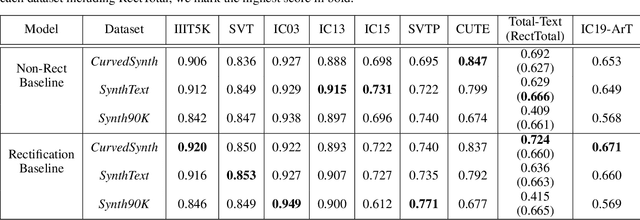


Abstract:Reading text from natural images is challenging due to the great variety in text font, color, size, complex background and etc.. The perspective distortion and non-linear spatial arrangement of characters make it further difficult. While rectification based method is intuitively grounded and has pushed the envelope by far, its potential is far from being well exploited. In this paper, we present a bag of tricks that prove to significantly improve the performance of rectification based method. On curved text dataset, our method achieves an accuracy of 89.6% on CUTE-80 and 76.3% on Total-Text, an improvement over previous state-of-the-art by 6.3% and 14.7% respectively. Furthermore, our combination of tricks helps us win the ICDAR 2019 Arbitrary-Shaped Text Challenge (Latin script), achieving an accuracy of 74.3% on the held-out test set. We release our code as well as data samples for further exploration at https://github.com/Jyouhou/ICDAR2019-ArT-Recognition-Alchemy
Symmetry-constrained Rectification Network for Scene Text Recognition
Aug 06, 2019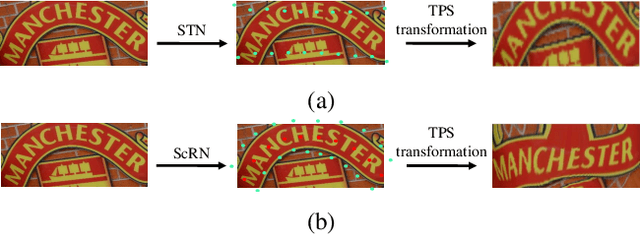
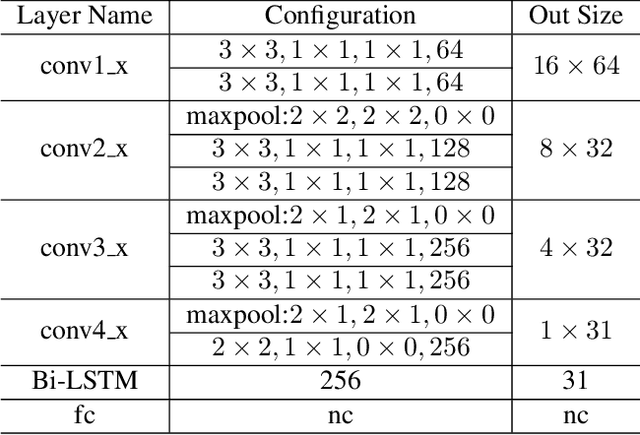


Abstract:Reading text in the wild is a very challenging task due to the diversity of text instances and the complexity of natural scenes. Recently, the community has paid increasing attention to the problem of recognizing text instances with irregular shapes. One intuitive and effective way to handle this problem is to rectify irregular text to a canonical form before recognition. However, these methods might struggle when dealing with highly curved or distorted text instances. To tackle this issue, we propose in this paper a Symmetry-constrained Rectification Network (ScRN) based on local attributes of text instances, such as center line, scale and orientation. Such constraints with an accurate description of text shape enable ScRN to generate better rectification results than existing methods and thus lead to higher recognition accuracy. Our method achieves state-of-the-art performance on text with both regular and irregular shapes. Specifically, the system outperforms existing algorithms by a large margin on datasets that contain quite a proportion of irregular text instances, e.g., ICDAR 2015, SVT-Perspective and CUTE80.
 Add to Chrome
Add to Chrome Add to Firefox
Add to Firefox Add to Edge
Add to Edge